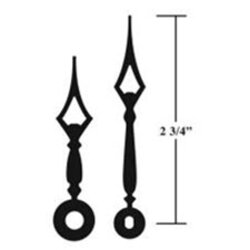+1 888 123 4567

How to Suit Big Clock Hands
Big clock hands are theoretically unrestricted in length, but practically talking you won't see any type of longer than eighteen inches, suggesting that the corresponding clock would certainly be at the very least a backyard in size. Also after that, the likeliest application for such a timepiece would be something installed directly to the wall (utilizing the wall as the dial, so to speak) without being confined in an instance.
Manufacturers have to tune to the pleasant area in the market, as well as for clocks that means diameters varying from a few inches to about ten to twelve inches. For this reason, clock activities (or electric motors) are supplied with just adequate power to revolve any and all hands falling in this array. This allows the producer to make just 2 variations of each movement, one with typical torque as well as one with high torque.
As one may visualize, higher torque needs more power, which will certainly drain pipes the battery quicker. Subsequently, this indicates that the batteries need to be changed more often. Obviously, the product utilized to make the hand is also a factor because not all products have the very same thickness or weight.
To put it simply, increasing the torque produced by a clock movement is a chief method of accommodating large hands. Yet one does not need to simply put up with these elements in order to use them to inform the correct time. We can likewise suit them stylistically to facilitate integrating them with the setting in which they are put. Undoubtedly, one should not neglect the advantages enjoyed from making certain that all of the timepiece components are collaborating in harmony.
High comparison in between the dial background as well as the numbers and hands laid over on it lessens eyestrain and improves a fast read of the time. This ensures that your clock exhibits great capability. Yet design is also essential, and also one ought to strive to achieve a unified look as well as compatibility. The designs for the dial and hands certainly don't need to be identical, yet they should be corresponding.
Each element has a statement to make; the hands as well as dial don't need to repeat the exact same declaration, but they mustn't clash or say with each other either. In the larger sizes, clock hands are rather limited in the selection of shapes (whereas the selection of lengths is sufficient). You can get a slim bar or a simple taper at one stylistic end, as well as a gothic or serpentine form at the other.
Arrow points are available, with or without a balancing ruby beside the placing opening. You should discover an adequate color choice so as to accomplish a solid contrast versus the dial face. Many dials are white, cream color, or beige (probably distressed); therefore, one of the most common shade option for hands is black.
Gold and also antique hands are also proper to comparison well, though not constantly, as well as for black or dark dial backgrounds you can pick white or silver hands. Finally, do not forget previouslies owned; these are normally optional, yet if you use them try a various shade (such as red) from the minute and hr hands, and also purpose to incorporate them harmoniously.
You have a lot of adaptability when developing clocks from scratch, as well as setting up can be a delight when you do your research beforehand. If your item is a huge watch, you ought to now understand just how to suit huge clock hands.
clock hands